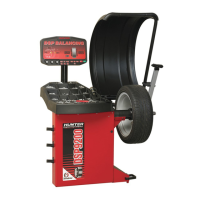Dynamic Imbalance
In general terms, dynamic imbalance is defined as where one or more locations of
the tire/wheel assembly are heavier causing an imbalance force and/or an imbalance
wobble. Shown below is a tire/wheel assembly with two heavy spots of equal weight
which are located 180 degrees radially from each other on opposite sides. As this
assembly rotates, centrifugal forces cause a large imbalance wobble to be created,
but the imbalance force (as well as the static imbalance) will be zero. A wheel with
this condition will cause a wobble or shimmy to be felt in the steering wheel.
Excessive dynamic imbalance of this type creates a shimmy that transfers through
the suspension components to the occupants of the vehicle, especially at higher
speeds.
IMBALANCE WOBBLE
(LATERAL TWIST OR TORQUE)
FRONT VIEW
ZERO STATIC IMBALANCE WITH LARGE
DYNAMIC (COUPLE) IMBALANCE
Modern “dynamic” balancers spin the wheel in order to measure both the up and
down imbalance force and the wobble or shimmy related imbalance (side-to-side).
Dynamic balancers direct the operator to place correction weights on the inside and
outside correction locations of the rim so that both imbalance force and imbalance
wobble will be eliminated.
IMBALANCE WOBBLE
(LATERAL TWIST OR TORQUE)
TOP VIEW
IMBALANCE FORCE
(UP & DOWN)
ZERO STATIC IMBALANCE (UP & DOWN)
+ ZERO COUPLE IMBALANCE (WOBBLE)
_____________________________________
= ZERO DYNAMIC BALANCE
14
2. Balancing Overview DSP9200 Series Balancer Operation Instructions

